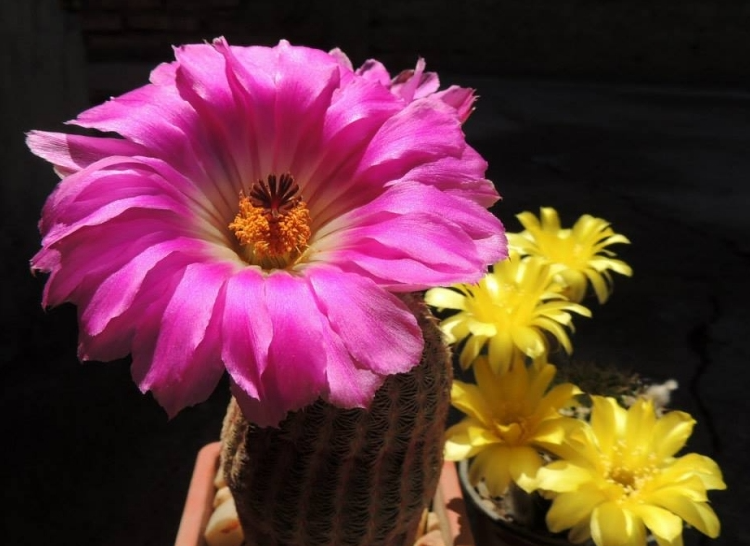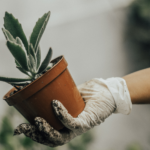If you’ve ever wandered down the succulent aisle and been captivated by a cactus adorned with deep purple spines and vibrant magenta blooms, you’ve likely met echinocereus rigidissimus rubispinus. This striking hedgehog cactus—often nicknamed the “Purple Spined Hedgehog”—is a desert-dweller with a personality as bold as its colors. Whether you’re a newbie scared of needles or a seasoned collector hunting a rare gem, this guide will walk you through everything from its taxonomy and natural haunts to tips on soil mixes and pest patrol. Ready to dig in?
About Echinocereus rigidissimus rubispinus

Imagine a plant that looks like a miniature armored fortress, topped with a crown of fireworks. That’s ECHINOCEREUS RIGIDISSIMUS RUBISPINUS for you—its rigid ribs and spines giving it medieval charm, its flowers bursting in shades of pink that could rival a desert sunset. Native to the Chihuahuan Desert, this species thrives on neglect, basking in scorching sun and living off minimal water. But don’t let its toughness fool you: under the right care, it rewards growers with a spectacular floral show that’s the envy of any succulent shelf. In this article, we’ll unpack its secrets step by step—no PhD in botany required.
Taxonomy and Nomenclature
Botanical Classification
Like all members of the Cactaceae family, echinocereus rigidissimus rubispinus falls under the order Caryophyllales. Within the genus Echinocereus, this species is one of several hedgehog cacti, distinguishable by its clustering habit and showy flowers. Subspecies rubispinus is prized for its purplish (hence “rubi”) spines, setting it apart from the green- or yellow-spined variants.
The Origin of the Name ‘rubispinus’
Latin roots often tell a plant’s backstory: “rubi-” means red or ruby, and “-spinus” refers to spines. Together, they describe the reddish-purple spines that give this cactus its flashy nickname. Imagine a gemstone encrusted fortress—that mental image nails the essence of rubispinus.
Natural Habitat and Distribution

Geographic Range in North America
This subspecies is found primarily in the western reaches of Texas and southeastern New Mexico, with pockets slipping into northern Mexico. It prefers rocky slopes and limestone outcrops, carving out niches where few competitors can survive.
Environmental Preferences
With daytime highs soaring past 100°F (38°C) and chilly nights that can dip to freezing, rubispinus is no stranger to extremes. Full sun exposure, well-draining soils, and sparse rainfall (often under 10 inches annually) shape its rugged lifestyle. Think of it as the desert’s own endurance athlete.
Distinctive Physical Characteristics
Stem and Rib Structure
Typically forming dense clusters of up to 6 inches (15 cm) in diameter, each stem sports 10–14 pronounced ribs. These ribs expand and contract like accordion bellows, allowing the cactus to swell during rare rains and shrink during droughts—a clever adaptation to erratic water availability.
Spine Coloration and Texture
Spines range from deep purple-maroon when young to grayish with age, fanning out in a radial pattern like a starburst. They feel stiff and can be slightly hooked, so handle with care or better yet, a pair of thick gloves.
Flower Morphology and Hue
Come spring, each stem can produce multiple flowers up to 3 inches (7.5 cm) across. Petals exhibit gradients from magenta to rosy pink, sometimes with a white throat. Opening in the morning sun, they close by late afternoon—your cue for a daily cactus flower show.
Flowering Behavior and Pollination
Blooming Season and Timing
Typically, rubispinus blooms from April through June. Peak bloom may only last a few weeks, making it feel like a rare desert spectacle—almost like catching a lunar eclipse.
Night vs Day Blooms
Unlike some echinocereus that open at night, rubispinus flowers are diurnal, greeting the sun with open petals and closing as temperatures drop. This daily ritual adds rhythm to your garden—like clockwork.
Pollinators and Pollination Mechanisms
Native bees, hawk moths, and even hummingbirds drop by for a sip of nectar, inadvertently dusting themselves with pollen. At home, you can hand-pollinate using a fine brush to transfer pollen between flowers, boosting your chances of seed set.
Cultivation Essentials

Ideal Soil Mix
This cactus demands rapid drainage. Combine one part coarse, inorganic grit (pumice, lava rock, or chicken grit), one part coarse builder’s sand, and one part high‑quality, low‑organic potting soil. The grit and sand create large air pockets that shed excess moisture, while the small proportion of organic material retains just enough nutrients. Aim for a final pH around 6.5–7.5; too acidic, and root health suffers. Always sterilize components if they’re recycled, to prevent fungal spores and pests.
Light and Temperature Requirements
In its native Chihuahuan Desert, rubispinus basks in full sun—ideally six to eight hours of direct light each day. Morning sun is gentler; introduce new plants gradually to avoid sunburn. Maintain daytime temperatures between 70–95 °F (21–35 °C) during the growing season. In winter dormancy, allow nights to drop to 40–50 °F (4–10 °C) but never below 25 °F (–4 °C). Indoors, position by a south- or west‑facing window; supplement with a grow light if natural light falls short.
Watering Schedule
Follow a “soak and dry” routine: water deeply until it runs through the drainage holes, then wait until the soil is bone‑dry before rewatering. During active growth (spring to early summer), this may be every 7–10 days, depending on heat and pot size. As summer heat intensifies and the cactus enters a brief rest, taper off. In fall and winter dormancy, water once every 4–6 weeks—just enough to prevent shriveling, not enough to promote growth.
Fertilization Practices
Use a balanced, low‑nitrogen cactus fertilizer (e.g., 5‑10‑10 NPK) at half label strength. Apply once a month from late spring through mid‑summer, after watering so roots can absorb nutrients. Avoid feeding in fall and winter to respect its natural dormancy cycle. Over‑fertilization leads to soft, pale growth and weakens the plant’s defenses against rot and pests.
Propagation Methods
Propagating Echinocereus rigidissimus rubispinus is easier than you might think—and gives you multiple ways to multiply your purple‑spined collection. Let’s dive into three reliable techniques:

Seed Propagation Techniques
Ever wanted to grow a cactus from scratch? Starting from seed is like raising a baby hedgehog cactus—exciting but requiring patience. Here’s how:
- Gather and Sterilize: Use fresh seeds from a reputable source. Sterilize your germination mix (1:1 coarse sand and peat-free potting soil) by baking at 180 °F (82 °C) for 30 minutes.
- Sow and Cover: Sprinkle seeds on the surface; don’t bury them—light aids germination. Mist gently with water and cover the tray with clear plastic or a humidity dome.
- Warmth and Light: Place under bright, indirect light with bottom heat of 70–75 °F (21–24 °C). In 2–4 weeks, you’ll see tiny white “pinheads” emerge—your future cactus army!
- Weaning Seedlings: Once cotyledons appear, remove the dome for an hour daily to toughen them up. After true spines form, slowly reduce humidity until they thrive independently.
Offsets and Clonal Division
Mature plants often produce pups—miniature clones hugging the mother. Think of these as natural, bonus babies:
- Wait for Size: Allow pups to reach ~1/3 the parent’s diameter so they have enough stored energy.
- Separation: Gently twist or use a sterilized knife to cut the pup away, including a small disk of the parent’s tissue.
- Callus Formation: Leave the pups in a dry, shaded spot for 3–5 days to form a callus over the cut—this prevents rot.
- Potting: Plant in the same gritty cactus mix, lightly mist, and resume normal watering after two weeks.
Grafting onto Rootstock
Want faster growth or exotic color forms? Grafting is your shortcut:
Aftercare: Once fused, remove bands and care for the grafted pair as one plant—enjoy earlier blooms and stronger stems!.
Choose Rootstock: Use a vigorous, disease‑free cactus like Hylocereus or Myrtillocactus.
Align Vascular Rings: Slice both rootstock and scion (your rubispinus piece) cleanly. Match the light‑colored rings for best sap flow.
Secure and Heal: Press together and wrap with rubber bands or grafting tape. Keep in bright, indirect light for 2–4 weeks.
Common Pests and Disease Management
Recognizing Infestations
Look for tiny webs (spider mites), cottony clusters (mealybugs), or sticky honeydew (scale insects). Early detection is like spotting a crack in your fortress before an army marches in.
Treatment Options
Use a cotton swab dipped in 70% isopropyl alcohol to wipe individual pests. For larger infestations, a gentle spray of insecticidal soap or neem oil can clear the battlefield—apply in the early morning to avoid scorching.
Preventative Measures
Quarantine new plants for 2–4 weeks. Keep humidity low and airflow high to deter fungus and bugs. A desert cactus hates a humid greenhouse as much as we’d hate a sauna
Landscape and Ornamental Applications
Xeriscaping Use
Drought-tolerant landscapes love rubispinus as a focal point among rocks and gravel. Its purple spines contrast beautifully with silvery agaves or pale yuccas.
Container and Indoor Display
In a shallow terracotta pot, this hedgehog cactus becomes a living centerpiece. Place it on a sunny windowsill, and rotate monthly for even growth—like turning a sculpture on display.
Rock Garden Integrations
Nestle small clumps between boulders to mimic its natural cliffside habitat. The rugged backdrop makes its vibrant blooms pop—think of it as nature’s still-life painting.
Ecological and Cultural Significance
Role in Desert Ecosystems
By offering nectar, rubispinus supports pollinators when few other plants bloom. Its dense roots stabilize soils, preventing erosion on rocky slopes—like natural rebar.
Traditional and Modern Uses
Some Indigenous communities historically used cactus pads for food and medicine, though rubispinus wasn’t a primary edible species. Today, collectors prize it as a conversation starter and a lesson in desert resilience.
Troubleshooting Common Growing Challenges
Yellowing stems usually signal overwatering; brown, sunburned patches indicate too-intense midday sun or sudden exposure. Stunted growth? Check for root rot or nutrient deficiency. Think of diagnosing cactus woes like detective work—observe clues, adjust variables, and monitor results.Even the hardiest cacti like echinocereus rigidissimus rubispinus hit snags now and then. Here’s how to spot and fix eight common issues:
- Overwatering: If water lingers in the pot, stems yellow and soften. Solution: reduce watering frequency and use a fast‑draining, gritty mix.
- Sunburn: Intense midday rays can scorch the epidermis, leaving bleached patches. Prevent by gradually acclimating plants to full sun or providing light shade during hottest hours.
- Etiolation: Insufficient light causes stems to stretch and pale. Correct by moving your cactus to a brighter spot with at least six hours of direct sunlight daily.
- Root Rot: Mushy base or foul odor signals rot. Cure by trimming affected roots, letting the base callus, then repotting in fresh, sterile, well‑draining soil.
- Pest Infestations: Mealybugs and spider mites show up as white fuzz or fine webs. Treat early with isopropyl alcohol wipes or insecticidal soap, repeating weekly until cleared.
- Nutrient Deficiency: Slow growth and faded spines can mean a lack of minerals. Feed monthly during the growing season with a balanced, low‑nitrogen cactus fertilizer at half strength.
- Cold Damage: Exposure below 25 °F (–4 °C) may blacken or collapse tissue. Shield outdoor plants with frost cloths or move them indoors to a cool, sunny spot on chilly nights.
- Poor Airflow: Stagnant air fosters fungal growth and rot. Ensure good ventilation by spacing plants apart and using a small fan in enclosed display areas.
Conclusion
Bold, beautiful, and built for extremes, echinocereus rigidissimus rubispinus is more than just a pretty spined cactus—it’s a testament to nature’s ingenuity. From its ruby-tipped armor to its morning magenta blooms, it brings desert drama to any collection. By understanding its native habitat and mimicking those conditions—gritty soil, full sun, and minimal water—you’ll enjoy a low-maintenance marvel. Ready to add this purple-spined hedgehog to your garden or shelf? With the tips in this guide, you’re well on your way to cultivating a desert gem that dazzles year after year.
Frequently Asked Questions (FAQs)
Q1: How often should I water Echinocereus rigidissimus rubispinus in summer?
Water deeply once the soil is completely dry, usually every 7–10 days, depending on temperature and pot size. Always err on the side of underwatering rather than overwatering.
Q2: Can I grow this cactus in a humid climate?
High humidity can invite rot and fungal issues. If you live in a humid area, ensure excellent drainage, use a gritty soil mix, and provide strong air circulation or a dehumidifier.
Q3: What temperature range is safe for overwintering?
Keep above 25°F (-4°C) and below 50°F (10°C) in winter dormancy. A cool, bright spot with minimal watering mimics its natural desert winter.
Q4: How long until flowering from seed?
Seeds sown under optimal conditions can bloom in 2–3 years. Patience pays off with a spectacular floral display.
Q5: Is Echinocereus rigidissimus rubispinus endangered in the wild?
It’s not currently listed as endangered but faces habitat pressure from development. Responsible nursery-grown specimens help reduce wild collecting.







